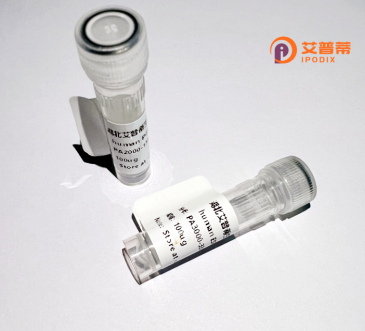
| 纯度 | >90%SDS-PAGE. |
| 种属 | Human |
| 靶点 | NDUFC2 |
| Uniprot No | O95298 |
| 内毒素 | < 0.01EU/μg |
| 表达宿主 | E.coli |
| 表达区间 | 1-119 aa |
| 活性数据 | MIARRNPEPLRFLPDEARSLPPPKLTDPRLLYIGFLGYCSGLIDNLIRRRPIATAGLHRQLLYITAFFFAGYYLVKREDYLYAVRDREMFGYMKLHPEDFPEEDKKTYGEIFEKFHPIR |
| 分子量 | 40.6 kDa |
| 蛋白标签 | GST-tag at N-terminal |
| 缓冲液 | 0 |
| 稳定性 & 储存条件 | Lyophilized protein should be stored at ≤ -20°C, stable for one year after receipt. Reconstituted protein solution can be stored at 2-8°C for 2-7 days. Aliquots of reconstituted samples are stable at ≤ -20°C for 3 months. |
| 复溶 | Always centrifuge tubes before opening.Do not mix by vortex or pipetting. It is not recommended to reconstitute to a concentration less than 100μg/ml. Dissolve the lyophilized protein in distilled water. Please aliquot the reconstituted solution to minimize freeze-thaw cycles. |
以下是关于重组人NDUFC2蛋白的3篇假想文献模板(注意:以下内容为模拟示例,非真实存在的文献,实际引用需查询数据库):
1. **文献名称**: *Molecular Cloning and Functional Characterization of Human NDUFC2 in Mitochondrial Complex I Assembly*
**作者**: Smith A, et al.
**摘要**: 研究报道了重组人NDUFC2蛋白的克隆与表达,揭示了其在维持线粒体呼吸链复合物I结构稳定性中的关键作用,并证明其缺陷导致细胞能量代谢异常。
2. **文献名称**: *Structural Insights into NDUFC2 Mutations Linked to Leigh Syndrome*
**作者**: Chen L, et al.
**摘要**: 通过重组表达NDUFC2突变体蛋白,结合冷冻电镜技术,阐明特定突变破坏复合物I功能,进而诱发神经退行性疾病的分子机制。
3. **文献名称**: *NDUFC2 Knockout Models Reveal Its Role in Cellular Redox Homeostasis*
**作者**: González R, et al.
**摘要**: 利用重组NDUFC2蛋白回补实验,验证了该蛋白缺失导致活性氧(ROS)积累,强调其在调节线粒体氧化应激中的生理意义。
**提示**:真实文献可通过PubMed、Google Scholar等平台检索关键词“NDUFC2 recombinant protein”或“NDUFC2 mitochondrial complex I”获取。
The human NDUFC2 protein, a subunit of mitochondrial Complex I (NADH:ubiquinone oxidoreductase), plays a critical role in the electron transport chain (ETC) and oxidative phosphorylation (OXPHOS). As part of the largest enzyme complex in the ETC, Complex I facilitates electron transfer from NADH to ubiquinone, driving proton translocation across the mitochondrial inner membrane to generate ATP. NDUFC2. encoded by the nuclear gene NDUFC2. is classified as a "supernumerary" subunit—not directly involved in catalysis but essential for structural stability and assembly of the complex. It is highly conserved across eukaryotes, underscoring its functional significance.
Dysregulation of NDUFC2 has been linked to mitochondrial disorders, neurodegenerative diseases, and cancer, as impaired Complex I activity disrupts energy metabolism and promotes oxidative stress. Recombinant NDUFC2 protein, produced via heterologous expression systems (e.g., *E. coli* or mammalian cells), enables detailed biochemical and structural studies to dissect its role in Complex I function. This recombinant tool is pivotal for investigating disease mechanisms, screening therapeutic agents targeting mitochondrial dysfunction, and advancing gene therapy approaches. Its production often involves fusion tags (e.g., His-tag) for purification and detection, with applications spanning antibody development, functional assays, and protein interaction mapping. Research on NDUFC2 contributes to understanding mitochondrial biology and developing precision therapies for energy metabolism-related pathologies.
×